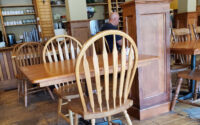Coureurs de bois were uniquely Canadian

I suspect that most Canadians have heard the phrase coureurs de bois and at least some of us have a vague idea who they were and what they did.
But I also suspect that very few of us know how truly unique these people were and what an important role they played in Canada’s early history.
When I was in school we learned of the coureurs de bois as sort of minor explorers and fur traders. They travelled the wilderness of eastern Canada across the great lakes and eventually down through the Mississippi valley in search of trade with the natives.
In the process they were the first white men to lay their eyes on much of this area.
More than explorers
But they were much more than explorers. In effect they were cultural ambassadors for the unique way of life that was taking shape in New France. In the British colonies to the south the primary objective was settlement and taming of the “wilderness”. This defined the relationship between the new settlers, the land they lusted after and the Indians who were its original occupants. In other words, it led to the inevitable seizure of Indian lands.
In New France things were different. It is true that Samuel de Champlain – the “Father of New France” strove for years to establish a French colony at Quebec and elsewhere along the St. Lawrence River. But the objective of Champlain’s sponsors back in France was primarily commercial. They were first and foremost interested in cashing in on the lucrative fur trade with the Indians of the area.
Champlain himself had a vision for the new French colony, but it was not one of occupation and domination. Over four decades starting from the early 1600s he was amazingly effective in establishing good relations with Indian nations right from Acadia (in Nova Scotia) to Huronia (in Ontario) and everywhere in between.
Champlain envisioned a society in which settlers and natives could live side by side in cooperation and harmony for the mutual benefit of both. Later in his mission to New France, Catholic missionaries played a larger role, attempting to convert Indians to Christianity. But there continued to be a general respect for native customs and language.
The contrast with how the Spanish treated Indians in Mexico and South and Central America is quite stunning. There it was clearly a question of conquest, with Indians treated as sub-human and often exploited as slaves – even by mission priests in many places.
Origins of the coureurs de bois
This never happened in New France. In fact Champlain negotiated with friendly tribes to have hand-picked bright and adverturous young men live with them for a year or two. The object was to learn their customs and language while building understanding and mutual respect between Europeans and natives.
These young men were later to serve as translators. Champlain called them truchements, and there were dozens of arrangements like this made in the first few decades of New France – the early 1600s.
Many of these young men became fully adjusted to the ways of the Indians, often becoming free agent fur traders, plying their trade along wilderness rivers never before visited by Europeans.
They would be away from “civilization” for years at a time, and often took an Indian wife. This way of life became so attractive to young Frenchmen that by the year 1680 it is estimated there were more than 800 coureurs de bois – out of a total population of just 9,700 in New France.
As the number of coureurs de bois grew, the French authorities in Quebec began losing control of the lucrative fur trade. In 1681 they instituted a sytem of licensing which forced independent fur traders to trade their goods through Montreal. Many coureurs de bois were thus converted into voyageurs – who were forced to give up their independence and become hired labourers for one of the established Montreal companies.
Many coureurs de bois remained stubbornly independent, but the writing was on the wall. It became increasingly difficult for them to operate in an environment controlled by a few large companies. Eventually they were displaced by licensed voyageurs.
Nevertheless, it was the young coureurs de bois of the 1600s who formed the defining spirit of a new culture that developed in the northern part of North America. These people were attracted to the wilderness, cherished their freedom, loved adventure, had an independent entrepreneurial spirit, and were tolerant of others who were different, as long as they shared their “live and let live” attitude.




Um U r very disgraceful to the first nations because the proper name and term used to describe them now is the first nations or aboriginals but not Indians, that was a term used before in history for a period of time, you have to also consider the fact that Columbus thought he was in India, so he called them Indians, but it’s a shame to see you knowing their not Indians, but referring to them by that name, imagine if someone called you indian and you aren’t even Indian.
but over all,, good solid info